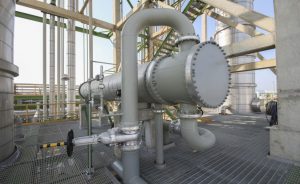These are the devices used for the exchange of heat between heated and heating working mediums.
There is a variety of heat exchangers. They are subdivided into surface (recuperative and regenerative) and open heat exchangers. In turn, surface heat exchanges are subdivided into shell and tube, double-pipe, plate, shell and plate, coil-wound, submersible, spray-type, and spiral.
The ESD company can supply heat exchangers of the following types:
- Shell and Tube Heat Exchangers
The main components of a shell and tube exchanger are a shell, small diameter tube bundles, tube sheets, nozzles, front and rear heads, stress compensation elements. One fluid runs through the tubes, and another fluid flows over the tubes to transfer heat between the two fluids.
Shell and tube exchangers are used to exchange heat between different fluids, vapors and gases and for thermal processes – with or without changing the state of aggregation – in condensers, heaters, and evaporators.

- Sectional Heat Exchangers
Sectional heat exchangers consist of consecutively assembled sections, each of them being a small-size shell and tube exchanger with one or several tubes located in a small-size cylindric housing. The sections are positioned horizontally or at a slight angle on frame supports, one under another, and connected into a group using U-bends or pipe elbows. If one group of apparatuses cannot provide a required capacity, then several operating in parallel groups may be employed. In sectional exchangers that are comparatively simple structurally, favorable heat transfer conditions are created even without internal baffles. A crossflow and uniform passage of heat transfer agents through the pipe orifice, as well as sufficiently high and more or less equal flow velocities of physically homogenous mediums are organized. The heat transfer intensification is performed there not only by means of flow velocity acceleration up to the maximum allowable value, but also owing to the application of pipes with longitudinal and low radial ribs.

- Double-Pipe Heat Exchangers
Exchangers of this type consist of a series of consecutively connected sections. Each section is designed as two coaxial pipes. To make cleaning and replacement easier, internal pipes are connected with either U-bends or elbows. Double-pipe exchangers have a sizeable heating surface; their sections are connected by manifolds in parallel. If one of heat transfer agents is a saturated steam, then as a rule it is led into the annulus. Such heat exchangers are often employed as liquid or gas-liquid exchangers. By selecting the diameters of inner and outer pipes, it is possible to provide the speed of both working mediums which required for the achievement of high heat transfer intensity.
Double-pipe heat exchanger advantages are as follows: high heat transfer ratio, applicability for heating or cooling high pressure mediums, fabrication, installation and maintenance simplicity.

- Plate Heat Exchangers (PHE)
Plate heat transfer equipment has become wide-spread owing to a compact design, possibility of its quick assembly, upgradability, and ease of cleaning from fouling.
A PHE consists of a pack of separated with rubber gaskets thin rectangular plates with portholes, through which two fluid streams flow, where heat transfer takes place. Other components are a frame plate (fixed plate), a pressure plate (movable plate), upper and lower bars and screws for compressing the pack of plates. The most important and most expensive part of a PHE is its thermal plates, which are made of metal, metal alloy, or even special graphite materials, depending on the application. The plates may be flat, but in most applications have corrugations that exert a strong influence on the thermal-hydraulic performance of the device.





